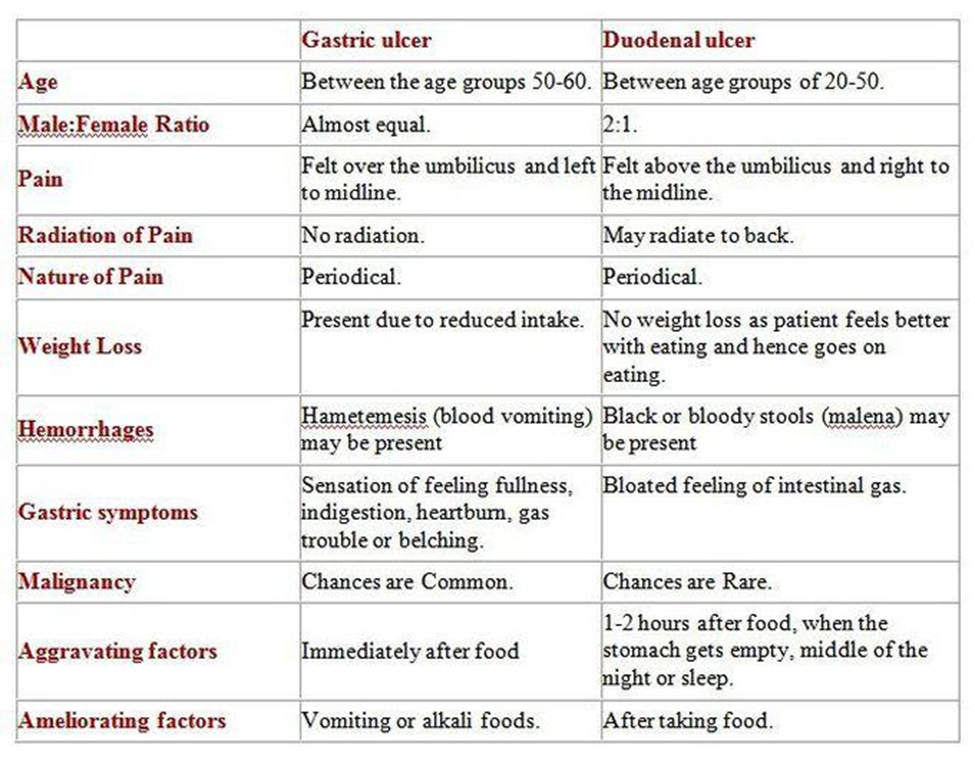What symptom is more common to a duodenal ulcer than a gastric ulcer?
Nighttime pain
Anorexia
Postprandial pain (occurring after a meal)
Nausea and vomiting
The Correct Answer is C
A) Nighttime pain:
Nighttime pain, also known as nocturnal pain, is a symptom associated with both duodenal and gastric ulcers. It occurs when the stomach or duodenal lining is empty and no food is present to buffer the effect of gastric acid. While nighttime pain can occur in both types of ulcers, it is not more specific to duodenal ulcers compared to gastric ulcers.
B) Anorexia:
Anorexia, or loss of appetite, can occur in both duodenal and gastric ulcers due to factors such as pain, discomfort, and inflammation. It is not a symptom that is more commonly associated with one type of ulcer over the other.
C) Postprandial pain (occurring after a meal).
Postprandial pain, which occurs after a meal, is more commonly associated with duodenal ulcers than gastric ulcers. This pain typically occurs 2 to 3 hours after eating, as it is often triggered by the release of gastric acid and duodenal contractions stimulated by food intake. Duodenal ulcers tend to cause this type of pain because they are located in the duodenum, the first part of the small intestine, which is exposed to gastric acid and bile after a meal.
D) Nausea and vomiting:
Nausea and vomiting can occur in both duodenal and gastric ulcers, particularly if the ulcer is accompanied by complications such as obstruction or perforation. These symptoms are not more specific to duodenal ulcers compared to gastric ulcers.

Nursing Test Bank
Naxlex Comprehensive Predictor Exams
Related Questions
Correct Answer is C
Explanation
A) Increase dosing with a large meal:
Increasing the dosing with a large meal may not be appropriate as it could lead to overdosing and potential side effects. The dosage of pancrelipase should be determined by the healthcare provider based on the individual's needs and response to treatment.
B) Take the medication at least 2 hours prior to meals:
Taking the medication prior to meals may not be effective as the enzymes will not be available when food is consumed, which defeats the purpose of enzyme replacement therapy. The enzymes need to be present simultaneously with the food to aid in digestion.
C) Take the medication with meals.
Pancrelipase, such as Cotazym, is a pancreatic enzyme replacement therapy used to aid in the digestion of fats, proteins, and carbohydrates in individuals with pancreatic insufficiency. Taking the medication with meals is crucial because it helps to ensure that the enzymes are available to aid in the digestion of food. Without proper enzyme supplementation during meals, individuals with pancreatic insufficiency may experience malabsorption, leading to nutritional deficiencies and gastrointestinal symptoms.
D) Decrease fluid intake:
Decreasing fluid intake is not appropriate as it could lead to dehydration and may not have any significant impact on the efficacy of pancrelipase. In fact, adequate fluid intake is important for digestion and overall health.
Correct Answer is ["A","B","E"]
Explanation
A. Metered-dose inhaler (MDI): MDIs deliver a specific dose of medication in aerosol form. They consist of a pressurized canister containing medication and a mouthpiece or mask for inhalation. Patients must coordinate inhalation with actuation to ensure proper medication delivery to the lungs.
B. Nebulizer: Nebulizers convert liquid medication into a fine mist that can be inhaled directly into the lungs. They are commonly used for patients who have difficulty using MDIs or require higher doses of medication. Nebulizers are often used in acute care settings or at home for patients with chronic respiratory conditions.
C. Hypodermic syringe: Hypodermic syringes are used for administering injections subcutaneously, intramuscularly, or intravenously. They are not used for inhalation medication administration.
D. Feeding tube syringe: Feeding tube syringes are used for administering liquid medications or enteral feeds through feeding tubes directly into the gastrointestinal tract. They are not used for inhalation medication administration.
E. Dry powder inhaler (DPI): DPIs deliver medication in powdered form, which is activated by the patient's inhalation. Unlike MDIs, DPIs do not require coordination between actuation and inhalation. Instead, patients inhale forcefully to disperse the medication into their lungs.
Whether you are a student looking to ace your exams or a practicing nurse seeking to enhance your expertise , our nursing education contents will empower you with the confidence and competence to make a difference in the lives of patients and become a respected leader in the healthcare field.
Visit Naxlex, invest in your future and unlock endless possibilities with our unparalleled nursing education contents today
Report Wrong Answer on the Current Question
Do you disagree with the answer? If yes, what is your expected answer? Explain.
Kindly be descriptive with the issue you are facing.
